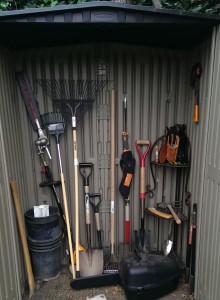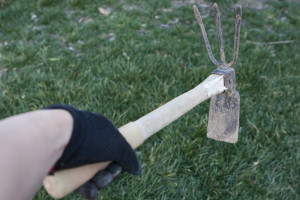Tools
 As with any task, having the correct tool(s) makes all the difference in the world. Whether you are crimping ethernet cables, working on your backhand, or digging a hole, the tool you hold in your hand will have an impact on your productivity and state of mind. Good tools increase productivity and great tools make work fun. Gardening is such an pleasant hobby on its own that often overlooked are the tools that enhance our enjoyment. Their ability to enhance our enjoyment may perhaps be a sign that tools are spirited–full of energy, enthusiasm, and determination. Therefore, the tools that are complimentary to our personality tend to be the most effective.
As with any task, having the correct tool(s) makes all the difference in the world. Whether you are crimping ethernet cables, working on your backhand, or digging a hole, the tool you hold in your hand will have an impact on your productivity and state of mind. Good tools increase productivity and great tools make work fun. Gardening is such an pleasant hobby on its own that often overlooked are the tools that enhance our enjoyment. Their ability to enhance our enjoyment may perhaps be a sign that tools are spirited–full of energy, enthusiasm, and determination. Therefore, the tools that are complimentary to our personality tend to be the most effective.
Moreover, the beginner gardener and those looking into gardening may be at a loss when trying to decide which tools to acquire first. The collected tools on this page are ordered with new gardeners in mind. If I had to build my collection all over again, this is the order in which I would go about it:
Garden trowel

I am going to start off with a curve ball. The garden trowel is a tool I would least likely to purchase right off the bat.
An iconic symbol for gardening, most tend to start their tool collection with one. It certainly was the case when I began to put my collection together. However, I quickly discovered that a garden trowel is one of the least enjoyable tools to use.
It is not designed to work against compacted dirt. The neck will bend and lose its integrity when willed against anything other than loose soil. For me, the garden trowel is a soil scoop that is often times less efficient than a pair of hands. If you cannot find a garden trowel in your parents garage, skip this purchase and consider investing in a hori hori knife.
Despite all of its shortcomings, there are times when a garden trowel is useful. Digging a hole or a plant out in a tight spot is pretty much all this tool is good for. This can be done with a much more useful tool like a hori hori knife.
Hand mattock with tiller
This tool goes by many other names: hand mattock, tiller mattock cultivator, cultivating mattock

The first gardening tool I would purchase is the hand mattock. Tools in general have a wide range of purposes. Often times, it is hard to imagine which ones will be effective in our hands. One way to narrow down the choices is by either observing or interviewing the professionals who use them.
The hand mattock is the tool that I have noticed that many landscape professionals use when they are weeding and planting. A tool that I use most often, it is both effective and convenient.
The mattock part of the tool is great against compacted soil. If there is a small area of new ground that I need to break, this tool both breaks it and also helps mix in the soil amendment. For plantings, the mattock can move a larger quantity of soil with less effort than a garden trowel. With a couple of strokes, a two foot by eight inch by four inch deep trench is dug. In addition to digging, the mattock is used to weed– swung underneath weeds to loosen their death grip so they may be pulled out.
While not used very often, the tiller is nice to have. Sometimes the tiller helps with mixing amendment into the soil or with breaking the top of the soil in order to sow seeds the have shallow planting depths.
Bypass pruner
If you have trees or bushes at your place, purchase the nicest pair of bypass pruner you can afford. Even if you have a gardener, a good pair of bypass pruner comes in handy from time to time. There might be some odd growth that gets in the way. The last thing you would want to do is to fight clean. Going in bare knuckle, you realize after the sixth back and forth bend that some plants are a tougher than they appear. Fight dirty, grab your pruner and give it one clean clip.
In the garden, it is surprising how often a pair of pruners are needed. Just the other day, I was planting Asiatic lily bulbs and found myself needing a pair of pruners to clear out some vegetation. Or I would walk by a tree on the way to water and notice that it needed to be pruned. Again, borrowing a page from the professionals, a pair of pruners are holstered on me.
Spade shovel with D-handle
Spade shovel with D-handle was one of the first tools purchased. It is useful for breaking into the first couple of feet of dirt. The D-handle is critical and helps maneuver the shovel when it comes time to moving dirt away from the hole. However, as you go deeper, the soil gets more compact; and while it is possible to continue to dig with a spade shovel, it will be not without effort.
[to be continued…]